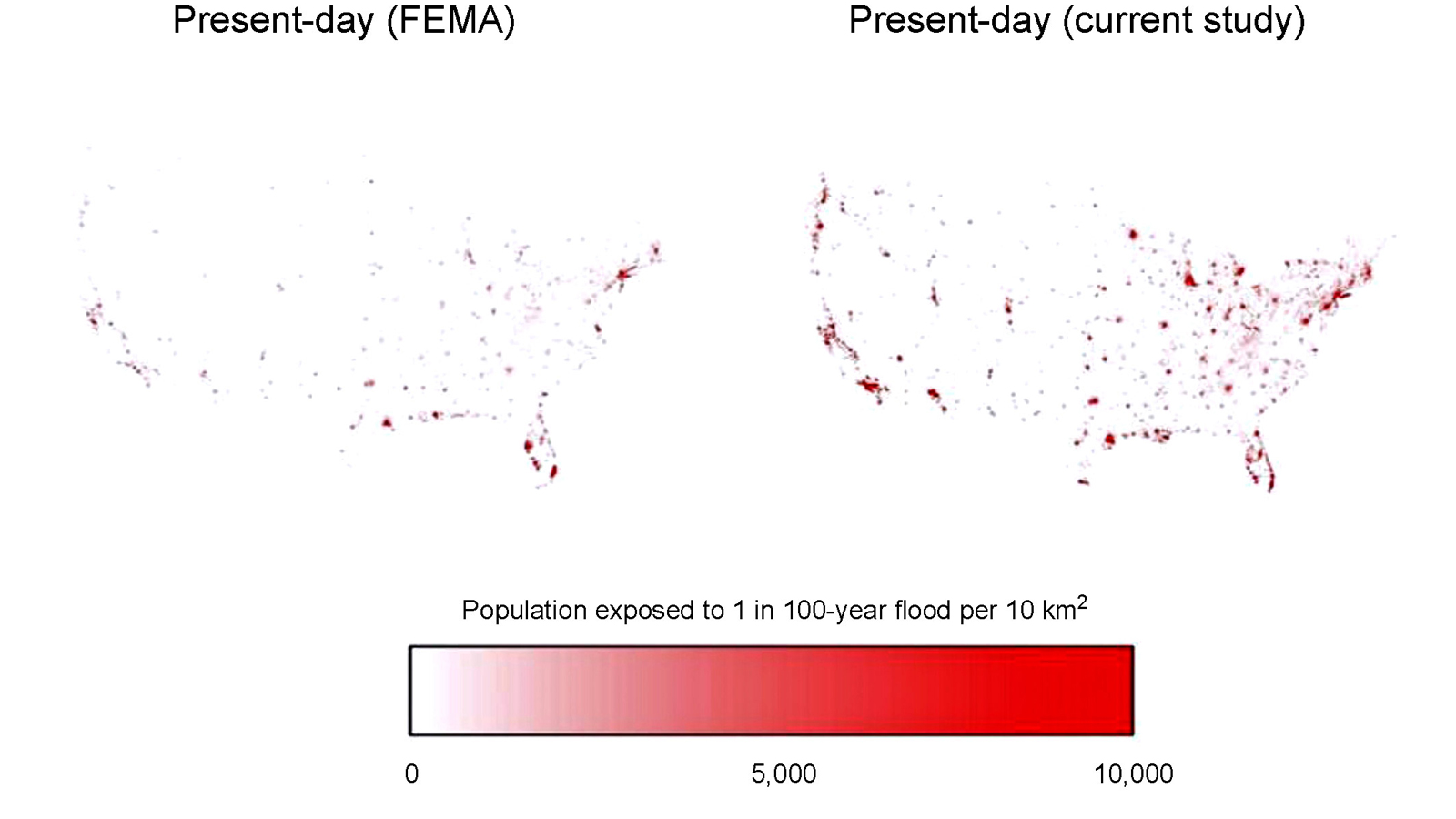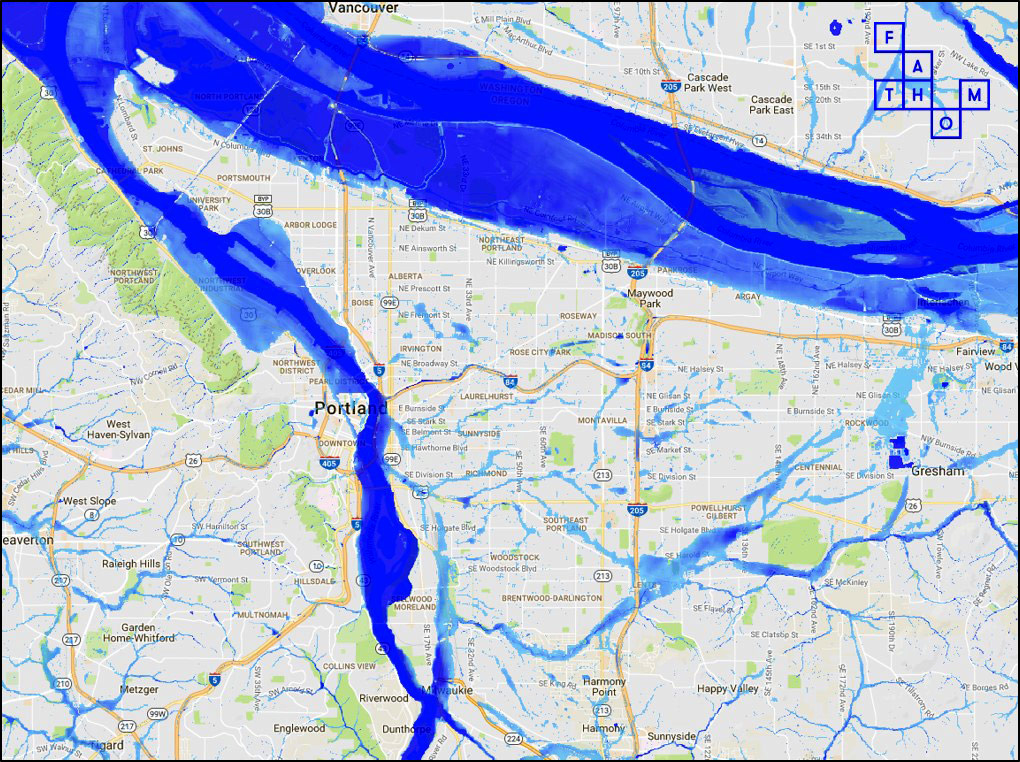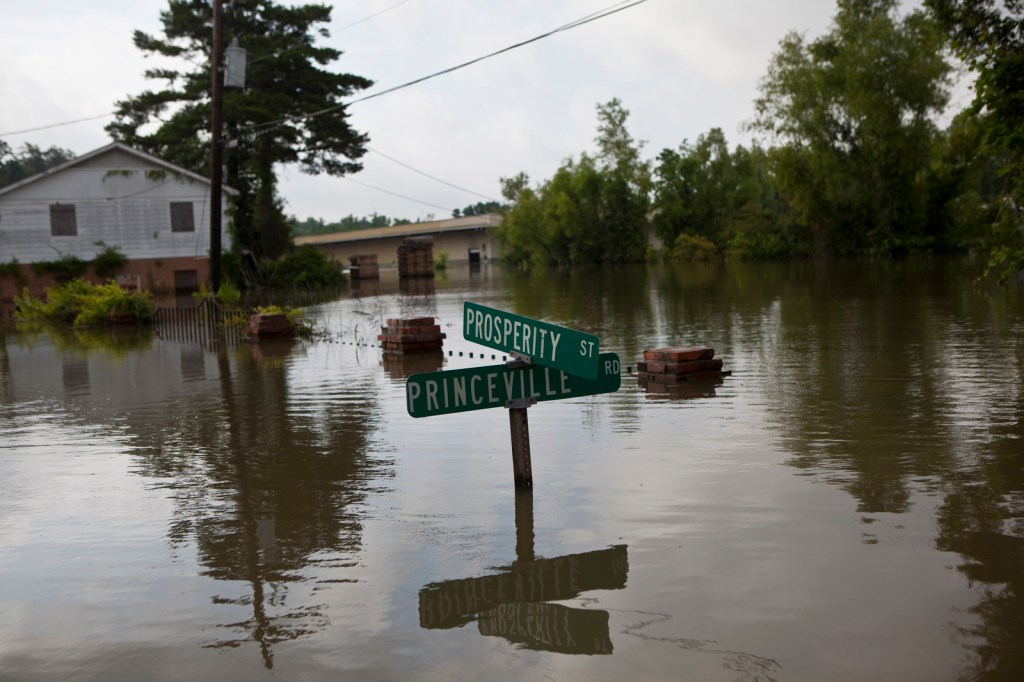A new paper publishing today in Environmental Research Letters has some sobering news for people living in the Lower 48 states: you may be at risk from river flooding and not even know it until the waters start to rise.
In fact, the study, “Estimates of present and future flood risk in the conterminous United States,” found that 41 million U.S. residents – about 13 percent of the entire population of the study area – are at risk from flooding along rivers. That’s about three times more than current estimates based on the regulatory flood maps produced by the Federal Emergency Management Agency (FEMA), which primarily map the areas at risk for 1-in-100-year floods in populous river basins.
Why the Big Difference? As Always, it’s All About the Data.
In general, FEMA prioritizes risk-assessment areas based on their population: reserving expensive, field-work intensive methodologies for the more populous river basins, adopting more approximate methodologies in others, and many rivers have not yet been mapped at all.
The sheer size of the U.S. means that flood maps generated in this way are incomplete – it would be too expensive and time-consuming to survey and model every river basin in the country. The national-scale flood maps produced by FEMA therefore constitute a patchy mosaic of local assessments that leave a large portion – about 40 percent – of the country and its flood risk unaccounted for.
For this research, scientists from The Nature Conservancy and other partners, including the University of Bristol in the U.K., adopted a pioneering methodology that avoids the pitfalls of the FEMA approach – where individual catchments are studied – by making use of big data and fast computers. The study used a new high-resolution model, produced by the flood-mapping organization Fathom, that simulates floods on all rivers across the entire continental United States.

“We were all surprised by how many people are actually exposed to freshwater flooding in the U.S.,” said Oliver Wing, lead researcher on the study and a PhD student at the University of Bristol. “It’s particularly worrisome considering that most of these people aren’t even aware of the risk they face. This study helps fill that critical information gap.”
Using streamflow data from the U.S. Geological Survey the research team was able to produce flood risk maps across the country, with a level of accuracy along specific rivers that compares well with the FEMA flood maps that presently serve as the primary source of flood hazard data in the U.S. The increase in numbers of people at risk shown in the study is a result of the expanded coverage of the map combined with the model’s ability to estimate flooding on small streams and flooding directly from rainfall – what hydrologists call “pluvial flooding.”
This is in contrast to flooding from rising rivers, called “fluvial flooding,” which both the new model and the FEMA model consider. The third type of flooding is “coastal flooding” from storm surges, which is already comprehensively modeled by FEMA and is not included in this study.
While the study fills gaps in floodplain mapping across the country, higher concentrations of newly identified risk are also particularly evident along the Pacific coast, in urban centers around the Great Lakes, and across inland western US.

You Can’t Manage a Risk You Aren’t Aware of
A clear understanding and assessment of flood risk only grows more urgent, Wing added, because people continue to build in harm’s way, often without realizing they are doing so. The study—which integrates new maps from the Environmental Protection Agency that more precisely estimate where people live now and where future population growth is expected—predicts that, under potential population growth and development projections, by 2050 more than 60 million U.S. residents may be vulnerable to “1-in-100-year,” or “one-percent,” floods.
“Because climate change may cause so-called 100-year floods to occur more frequently, even more people may be exposed to flooding in the future. All of this highlights the critical need for comprehensive floodplain and flood risk management planning,” Wing said.
The Good News: Nature Finds a Way
Kris Johnson, a Conservancy scientist and co-author of the study, said, “By knowing those places most at risk from floods, we could avoid development in these areas. Protecting floodplains or developing them in ways that can withstand flooding—such as flood-tolerant parks—can prevent unnecessary risk to people and help avoid expensive damage to property and infrastructure. Floodplains also store and convey floodwaters, which can help prevent flooding in nearby communities.”
The many important values of floodplains – including their irreplaceable role in protecting wildlife — are a key reason the Conservancy has been working specifically on floodplain management and conservation for decades. From protected areas like Emiquon on the Illinois River to Mollicy Farms on the Ouachita in Louisiana, the Conservancy is showing that restored and managed floodplains can store and convey water during flood events, lowering the flood stage for communities upstream and downstream.

Floodplains have a place in more highly urban settings as well. More than 40 years ago the US Army Corps of Engineers concluded that protecting wetlands and floodplains in the Charles River watershed was the most cost-effective way to reduce potential flood damages downstream in Boston. Protecting floodplains has proven effective in multiple places in the U.S. and around the world but is too often overlooked as a cost-effective strategy to mitigate flood risk.
To capture all the values of floodplains, including their fundamental importance to providing habitat for wildlife, the Conservancy has also partnered with the American Planning Association, the American Society of Civil Engineers, the Association of State Floodplain Managers, and the National Association of Counties on a project called “Naturally Resilient Communities.” It’s a partnership designed to help communities use nature-based solutions to address multiple needs, with a focus on reducing impacts from floods and storms.
Forewarned is Forearmed
When it comes to flooding, the best risk is the avoided one. The study calculated that in the continental U.S. there already exists $5.5 trillion worth of assets in areas subject to 100-year floods, with a potential of $1.2 trillion worth of damage to these assets if every area experienced such an event. Better planning and the protection of floodplains, Johnson said, is particularly important as average flood losses in the U.S. have steadily increased to at least $10 billion annually.
A new paper has some sobering news for people living in the Lower 48 states: you may be at risk from river flooding and not even know it until the waters start to rise.
One measure of this is the current debt of the National Flood Insurance Program, which now stands at some $24.6 billion. Congress also appropriated over $100 billion in response to hurricanes Harvey, Irma and Maria, much of which will aid areas impacted by flood damages.
“Floodplains provide high quality habitats for wildlife, they can offer outstanding recreational opportunities for people, and they help improve water quality,” Johnson said. “Protecting and restoring the natural infrastructure of floodplains provides an important complement to built infrastructure like dams and levees. We need comprehensive approaches to reduce the devastating effects that flooding has on so many communities.




Just saw this in “Nature Conservancy.” Old news? Did it get much publicity when it came out in Feb?
In what pubs?
Have you done any more work on this? Specific rivers and areas that might flood would be of interest to the general reader.
They keep calling this a 100 year event, I believe the flooding will become a ever worsening yearly event. This is do to drastic accelerated climate change due to vast amounts of frozen methane pools melting in the north. Most scientists have failed to factor in these facts in their studies. And give 50 to 100 year protections on water levels rising. There are scientists out there who tell the truth in the nextfew years millions of people will be displaced. Due to rising water levels all over the world.
Michael
It is really important to be safe before and after floods. We cannot risk our families lives. Thanks to the government for doing everything to help us get through it. If you need help on water damage restoration or flood water removal, just visit our website http://floodfloodflood.com/.
I can speak first hand about losing everything to a flood. October 4, 2015 I lost EVERYTHING. Both cars, everything in my house, my house and almost my two daughters. FEMA is a joke. I now know why the people haven’t moved back to New Orleans….because they can’t afford it. We were looking at over $100,000 in damages, when FEMA offered us just over $13,000. Even though we couldn’t live there, we were sill having to pay our mortgage through Mr Cooper because I couldn’t ever speak with anyone or get anyone to contact me back. My credit card debt climbed over $30,000 just trying to get things straight, and now I’m trying to pay that off, even though I’ll never be able to unless I win the lottery. It worries and frightens me because my girls deserve better, and so do I, but unless a miracle happens, I’ll be slaving until the day I die to try to pay for it all.
It be nice if you could make a list of the towns that are at risk, so we get a heads up. Not depending on the gov’t to provide that information with this new findings.
How can we establish more riparian forests to help mitigate the risk?
Hi. PEOPLE need to build electric vehicles. I am talking about electric cars, trucks, trains, boats, and planes! ALL transportation needs to be electric! That will never happen because too many people who ‘run-the-world’ have links! Rich people get richer through the purchase and sale of gas! Meanwhile the world population continues to GROW! The most important problem on our planet is >>> [ROBOTS]!! [THEY] are steeling jobs!! AGAIN … the same PEOPLE who get money by buying and selling gas >> their buddies are those who build and use [ROBOTS]! They are aware of the fact that it is cheaper to use [ROBOTS] instead of PAYING humans! David Kirts
I’m still confused by the differences between FEMA maps and this new study, both in areas impacted and in the reasons for the differences. I guess I should look up the original study, but this article seems to be saying that the fluvial/pluvial difference is the main one. Given how dependent pluvial flooding is on stormwater infrastructure, I’m wondering if the new study has a better model of this than FEMA? How much of the difference is between the better modeling, versus differences in what is modeled? How much is based on a different estimate of what a 100 year flood would be? Many areas of the country have experienced multiple 100 year floods in the past decade, raising the question of whether the original 100 year floods were calculated correctly, especially with climate change….
Hi Connor,
Thanks for the questions! There are two primary themes to the differences between our model and FEMA maps. The first is that we’ve modelled whole swathes of land that FEMA hasn’t: by our calculations, FEMA has studied 60% of the land area of the lower 48. This is because of FEMA’s “bottom-up” approach to flood mapping, where their “national” flood map is an accumulation of local assessments (that have not taken place everywhere in the country). Our methodology is “top-down”, in that we adopt an automated model build that makes use of high-resolution, large-scale, remotely-sensed data sets (e.g. USGS topography and river gauge data) to produce flood maps with complete coverage of the entire conterminous US. In this respect, our model can complement FEMA maps by filling in the data gaps.
The second main difference arises from what we have modelled where FEMA has also carried out an assessment. We found that even within the 60% of the country FEMA claims to have studied, there is a general tendency to focus on the primary streams within a river basin and ignore smaller tributaries and headwaters. We know from historical events that floods like these can be very damaging (e.g. flooding in central Europe in 2013). Our pluvial model component, as well as simulating surface water hazard, can simulate flooding from these smaller streams. I’ll point you towards some literature below as to why we do this, but essentially these headwater streams exhibit “flashy” flood responses to intense rainfall, rather than the aggregation effects of larger rivers, so are captured more accurately in the pluvial, rather than fluvial, model component. You’re correct in that pluvial hazard is dependent on stormwater infrastructure, and we’ve done our best to account for this by assuming a certain drainage capacity in urban areas. The main point here, however, is that FEMA does not simulate pluvial flooding at all, so any off-floodplain, “hydrologically-disconnected” flooding from short, intense rainfall events do not inform flood zone delineation.
Where FEMA maps actually exist, we absolutely do not claim to have a better idea of flood hazard there. In fact, we validated our model against the entire catalogue of FEMA maps, as well as dozens of USGS flood inundation studies, and found pretty good agreement between our large-scale approach and these local maps where they exist. See the study here, which details our methodology more fully: http://onlinelibrary.wiley.com/doi/10.1002/2017WR020917/full; and do take a look at the paper that this blog is the subject of here: http://iopscience.iop.org/article/10.1088/1748-9326/aaac65. Feel free to reply with any further questions or drop me an email at oliver.wing@bristol.ac.uk.